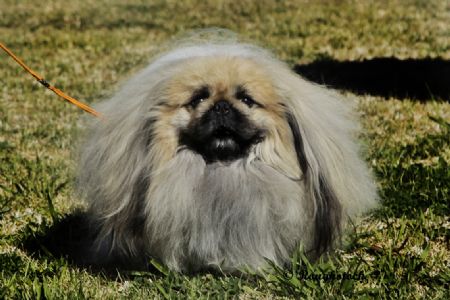Pekingese

Also known as the Little Lion Dog.
The Pekingese is an ancient breed and companion dog, and its name refers to the city of Peking in Beijing home of the forbidden city. They are called Lion-Dogs due to their resemblance to Chinese Guardian Lions.
The Pekingese breed is over 2000 years old and has hardly changed in all that time. One exception is that modern breeders and dog-show judges seem to prefer the long-haired type over the more-traditional spaniel-type coat.
The breed originated in China in antiquity. Recent DNA analysis confirms that the Pekingese breed is one of the oldest breeds of dogs, one of the least genetically diverged from the wolf. For centuries, they could be owned by members of the Chinese Imperial Court. During the Second Opium War, in 1860, the Old Summer Palace in Beijing was occupied by a contingent of British and French troops. The Emperor Xianfeng had fled with all of his cour. However, an elderly aunt of the emperor remained. When the British and French troops entered, she committed suicide. She was found with her five Pekingese mourning her death. They were removed by the Allies before the Summer Palace was burnt to the ground. Lord John Hay took a pair, later called Schloff and Hytien, and gave them to his sister, the Duchess of Wellington. Sir George Fitzroy took another pair, and gave them to his cousins, the Duke and Duchess of Richmond and Gordon. Lieutenant Dunne presented the fifth Pekingese to Queen Victoria, who named it Looty. The Empress Dowager Cixi presented Pekingese to several Americans, including John Pierpont Morgan and Alice Lee Roosevelt Longworth, daughter of Theodore Roosevelt, who named it Manchu. The first Pekingese in Ireland was introduced by Dr. Heuston. He established small pox vaccination clinics in China. The effect was dramatic. In gratitude, the Chinese minister, Li Hongzhang presented him with a pair of Pekingese. They were named Chang and Lady Li. Dr. Heuston founded the Greystones kennel. Around the turn of the century, Pekingese dogs became popular in Western countries. They were owned by such arbiters of fashion as Queen Alexandra of the United Kingdom, and Elsie de Wolfe, popular American interior decorator. Sleeve Pekingese: The name Sleeve Pekingesecame from the custom of carrying these small dogs in the capacious sleeves of the robes worn by members of the Chinese Imperial Household. Hubbard indicated that this tradition appeared to be early Italian rather than Chinese, but its adoption by the Chinese Imperial Household led to dogs being bred as small as possible and to practices aimed at stunting their growth: giving puppies rice wine, holding new-borns tightly for hours at a time or putting the puppies into tight-fitting wire mesh waistcoats. These practices were apparently forbidden by the late Dowager Empress Tzu Hsi. The Dowager Empress' desire for the Pekingese; also known as the PEARLS a standard still adhered to today:
Pekingese Legends:
A lion and a marmoset fell in love. But the lion was too large. The lion went to the Buddha and told him of his woes. The Buddha allowed the lion to shrink down to the size of the marmoset. And the Pekingese was the result.
A lion fell in love with a butterfly. But the butterfly and lion knew the difference in size was too much to overcome. Together they went to see the Buddha, who allowed their size to meet in the middle. From this, the Pekingese came.
Another legend says that the breed resulted from the mating of a lion and a monkey, getting its nobleness and coat from the former and its ungainly walk from the latter. Because the Pekingese was believed to have originated from the Buddha, he was a temple dog. As such, he was not a mere toy. He was made small so that he could go after and destroy little demons that might infest the palace or temple. But his heart was big so that he could destroy even the largest and fiercest.